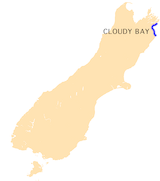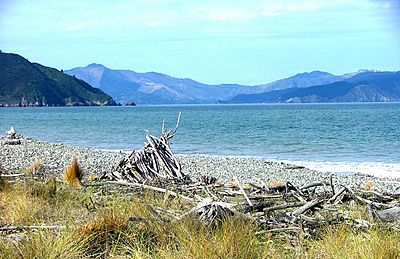Te Koko-o-Kupe / Cloudy Bay facts for kids
Te Koko-o-Kupe / Cloudy Bay, often just called Cloudy Bay, is a bay in the northeast of New Zealand's South Island. It sits south of the Marlborough Sounds and north of Clifford Bay. In August 2014, the bay's name was officially changed to Te Koko-o-Kupe / Cloudy Bay. The Māori name remembers an early explorer named Kupe. He was said to have scooped up oysters from the bay.
Cloudy Bay also gives its name to a very famous white wine. This wine is called Cloudy Bay Vineyards Sauvignon Blanc. However, the grapes for this wine are actually grown further inland in the Marlborough wine region.
Contents
What Makes Cloudy Bay Special?
Cloudy Bay faces the Cook Strait, which is a body of water between New Zealand's two main islands. The bay stretches about 30 kilometers (19 miles) from north to south. Its northern end is at Port Underwood, which is part of the Marlborough Sounds. The southern end reaches White Bluffs.
The Wairau River flows into the sea here, creating a delta. The river reaches the sea at two different spots. The southern spot forms an entrance to a large area of water called the Big Lagoon. This lagoon is just north of White Bluffs. The middle point where the river meets the sea is known as the Wairau Diversion. There is also a popular swimming spot to the north called Whites Bay.
Rarangi: A Coastal Community
About a 15-minute drive from the center of Blenheim is a lovely coastal community called Rarangi. It is located in the northern part of Cloudy Bay. Rarangi has an older part with traditional New Zealand holiday homes, called bachs or cribs. There are also some very nice modern homes.
A newer area has been built in the central part of Cloudy Bay. This area is closer to the Wairau Diversion, a man-made river. This newer part of Rarangi also has high-quality homes. Some are right on the beachfront, while others are a bit further inland.
A Look into Cloudy Bay's Past
Cloudy Bay has a rich history. People have lived there for a very long time.
Early Māori Life
Archaeologists have found evidence that Māori lived at a place called Wairau Bar. This was during a time known as the 'moa-hunter' period. This was around the years 1288 to 1300. They lived there for about 20 years. This site is the oldest and most studied place of early Polynesian settlement in New Zealand.
European Arrivals
Captain James Cook named Cloudy Bay on February 7, 1770. Later, around 1826, seal hunters started visiting the area. They set up stations at Port Underwood, which is a deep inlet at the north end of the bay.
Whalers soon followed the sealers. In 1828, a whaler named John Guard started a whaling station at Port Underwood. His ship was called the Waterloo. By 1840, there were about 150 Europeans living in the area. This was probably the largest group of Europeans in the South Island at that time.
Between 1829 and 1832, Guard's ship, the Waterloo, made three trips a year to Sydney, Australia. It carried seal skins, flax, and whale oil to sell. It brought back supplies and trade goods. In 1832, Guard put Captain Hall in charge of the Waterloo.
The Treaty of Waitangi
An important event happened on June 17, 1840. The Treaty of Waitangi was signed by South Island chiefs at Horahora-Kakahu Island. This island is just off the coast from Port Underwood. The treaty was being carried around the New Zealand coast on a ship called HMS Herald.




